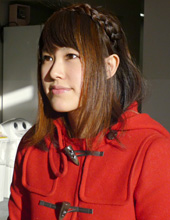Top>Hakumon CHUO [2011 Early Spring Issue]>[People shown on the cover] Award recipient in the Future Dream Idea Contest to conduct user interface research at Tokyo University Graduate School
 Index
Index
People shown on the cover
Award recipient in the Future Dream Idea Contest to conduct user interface research at Tokyo University Graduate School
Ayumi Kato
Faculty of Science and Engineering (Kanagawa Prefectural Atsugi High School graduate)

In the 3rd Techno-Renaissance Japan (sponsored by Nikkei Inc.),which was known as "the Future Dream for Enterprise Research Idea Contest," Ayumi Kato received the Techno-Renaissance Japan Award. This contest, with the theme of "This product should make for a brighter future," pitted ideas from science and technology-orientated students against each other, and from a total of more than 400 entries, Kato's entry titled Applications which extract onomatopoeia included in word-of-mouth information and search for food preferences, captured the prize in style.
Focusing on onomatopoeic and mimetic function words/ Making use of them in food evaluation phrases
Onomatopoeia is the overall term for onomatopoeic and mimetic words that give more intuitive and emotional expression to things and scenes, and which are often used in our everyday life.
The catalyst that led to the award-winning idea came from a familiar place. "When looking for restaurants on the internet," Kato says, "in addition to a restaurant's atmosphere and prices, the only evaluation ranking in regard to taste is 'delicious.' There is no information on the way in which something is delicious."
Noticing this, Kato says she focused on "onomatopoeic words used in word-of-mouth information for bagels such as 'chewy' and 'fluffy' ", and adds "I thought about bringing those phrases to the top of food evaluation items."
She focused on onomatopoeic and mimetic words that can convey slight nuances that can't be described well in plain language. Kato explains that "I thought it would be good to have something like this in my third year at university." She received a good response when she made a presentation as a fourth year student in her research laboratory, and that led to her entering the contest.
A user-friendly system/ Going to graduate school at Tokyo University
For a long time Kato thought "I want to create a simple, user-centered system that everybody can use." Looking back, she continues, "I had it in my head when I first entered university. I became even more conscious of it in my third year after meeting seniors at conferences and taking Professor Toshikazu Kato's class."
While there is a tendency for students to spend their university days aimlessly and passively, Kato observed society from her own viewpoint. As a second year student, she even attended WISE, an event for female students in the Faculty of Science and Engineering which looks at career advancement. Kato was one of the members who changed WISE, an event which had, until then, been run predominantly by the university, into one which involved students in its operations.
She says that, "In the future, it is important to have a system which puts the user at the forefront and not only promotes the "fastest" and "smallest" products, as the situation has been up to now." In order to realize this dream, Kato decided to continue her studies at the University of Tokyo Graduate School of Interdisciplinary Information Studies.
Kato displays an upbeat attitude about her new research when she says, "The research here is scientific, but unified research, which incorporates an artistic viewpoint that is absolutely necessary for interfaces, is also undertaken in a positive manner. Everyone is taking up their own challenges."
Grateful for the support from her professors/ Creating products that don't just focus on functionality
However, the road to acceptance into Tokyo University's graduate school had its difficulties. In addition to a written exam, Kato had to submit a research plan, and if there were points she had trouble with, Kato would actively seek advice from professors, even those outside of her department. She expresses her gratitude in saying, "All the professors were accommodating in giving me guidance. My professor, Hisashi Suzuki, was at the university every day during the summer holidays just before my exams to give me encouragement, and Professor Toshikazu Kato also gave me a great amount of moral support."
"Products which only focus on function leave the user behind. That is why I want to learn about user interfaces," says Kato, who we can pin our hopes on for creating a future with a bridge between people and gadgets.
(Komuro)
- Research Activities as a Member of Research Fellowship for Young Scientists (DC1), Japan Society for the Promotion of Science (JSPS) Shuma Tsurumi
- Important Factors for Innovation in Payment Services Nobuhiko Sugiura
- Beyond the Concepts of Fellow Citizens and Foreigners— To Achieve SDGs Goal 10 “Reduce Inequality Within and Among Countries” Rika Lee
- Diary of Struggles in Cambodia Fumie Fukuoka
- How Can We Measure Learning Ability?
—Analysis of a Competency Self-Assessment Questionnaire— Yu Saito / Yoko Neha - The Making of the Movie Kirakira Megane








